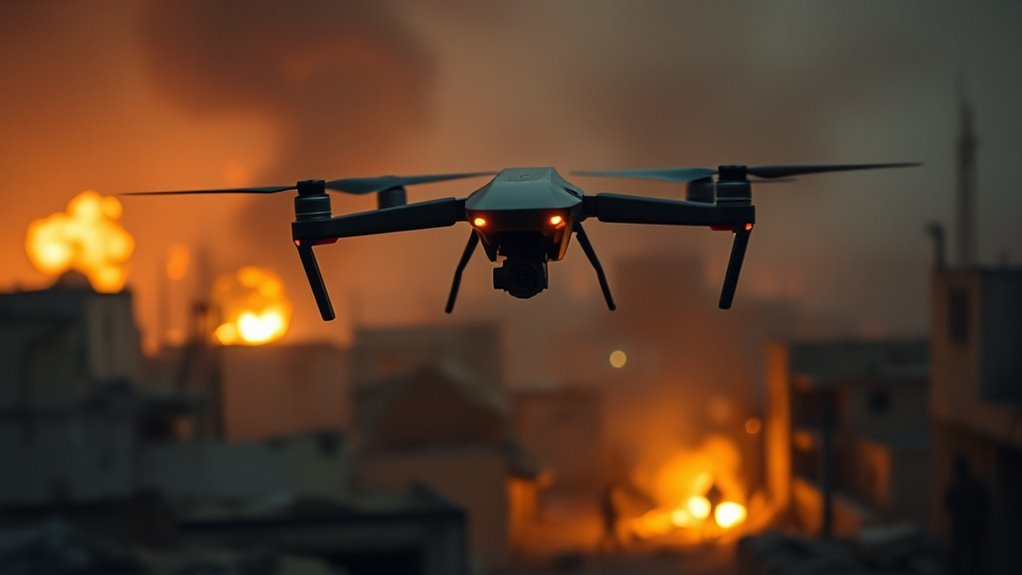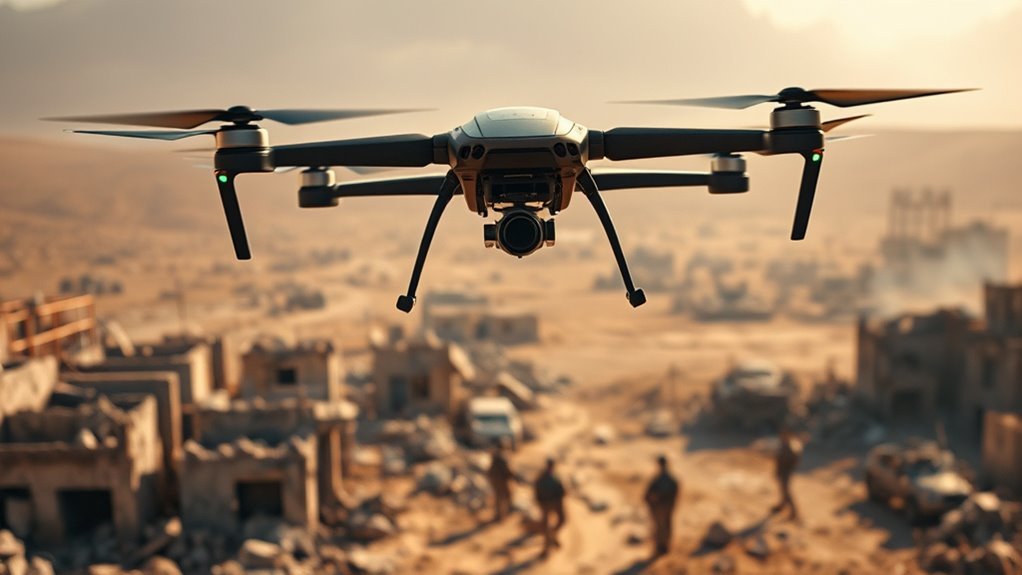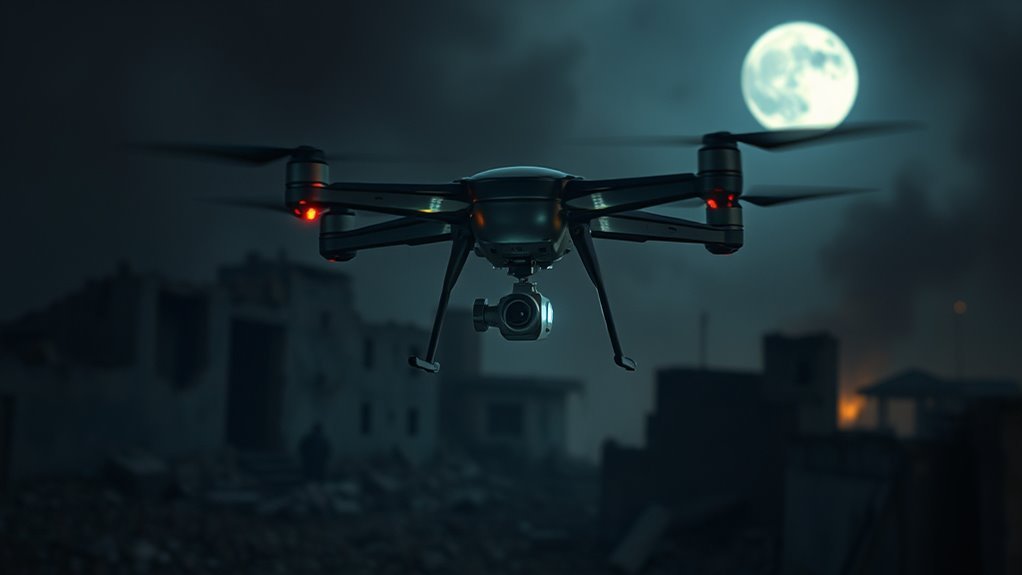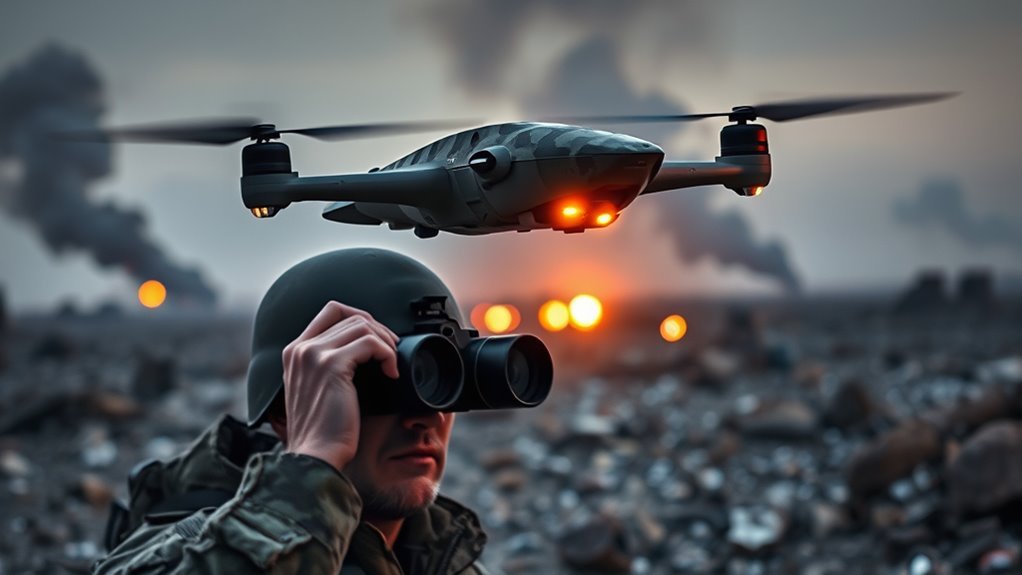Mosquito drones serve multiple functions in a warzone. They excel in surveillance and reconnaissance by providing real-time data and high-resolution imagery without personnel risk. Their targeted payload delivery minimizes collateral damage, while their communication relay guarantees secure connections among units. Equipped with advanced sensors, they facilitate intelligence gathering for swift decision-making. Additionally, they engage in psychological operations by inducing fear and disseminating propaganda. These capabilities highlight their strategic importance, and there’s more to uncover about their applications.
Surveillance and Reconnaissance

As military operations evolve, the integration of mosquito drones for surveillance and reconnaissance becomes increasingly significant. These drones leverage advanced drone capabilities, enabling real-time data collection in challenging environments. Their small size allows them to operate discreetly, reducing the risk of detection while gathering critical intelligence.
Incorporating this technology provides strategic advantages, such as enhanced situational awareness and the ability to monitor enemy movements without risking personnel. The drones can navigate tight spaces and gather high-resolution imagery, making them indispensable for tactical assessments.
Targeted Payload Delivery

Following the advancements in surveillance and reconnaissance, mosquito drones are now being utilized for targeted payload delivery in combat scenarios. These drones excel in precision targeting, allowing you to hit specific objectives with minimal collateral damage. By optimizing payloads, you can guarantee that munitions are effectively deployed, enhancing operational efficiency. The small size and agile nature of mosquito drones facilitate discreet approaches, making them ideal for situations where conventional methods may be too conspicuous or risky. With the ability to carry diverse payloads, from medical supplies to tactical equipment, these drones represent a significant evolution in warfare logistics. Overall, their innovative design enables you to maintain strategic advantages while adhering to principles of precision and responsibility in conflict zones.
Communication Relay

While traditional communication methods can be vulnerable to interception and disruption in combat environments, mosquito drones offer a robust solution for secure communication relay. These drones utilize advanced drone navigation systems to maneuver through challenging terrains, ensuring reliable connectivity between units. By employing signal amplification technology, they enhance communication range and clarity, making sure vital information is conveyed without interruption. This capability is particularly important in dynamic battlefields where real-time coordination is essential. With their small size and agility, mosquito drones can navigate through obstacles, maintaining secure lines of communication that larger systems might struggle to achieve. Ultimately, integrating these drones into military operations can greatly enhance operational effectiveness and resilience against adversarial threats. Additionally, their design can draw inspiration from advanced LED systems like those found in Intel Shooting Star drones, enhancing visibility during night missions. Furthermore, the use of AI Stability Control in drone technology ensures smoother navigation, which is crucial in maintaining effective communication pathways.
Intelligence Gathering
Mosquito drones play an essential role in intelligence gathering, particularly in environments where traditional reconnaissance methods may fall short. Equipped with advanced sensor technology, they can capture high-resolution imagery and monitor environmental conditions discreetly. The data collected undergoes rigorous data analysis to extract actionable insights, enhancing situational awareness for military personnel.
| Function | Impact |
|---|---|
| Real-time monitoring | Enables swift decision-making |
| Covert operations | Reduces detection risks |
| Terrain mapping | Aids strategic planning |
| Threat identification | Improves safety measures |
This integration of innovative technology not only contributes to tactical effectiveness but also empowers forces to operate with greater autonomy and safety in complex warzones.
Psychological Operations
In the context of psychological operations, the mosquito drone’s capabilities extend beyond intelligence gathering to include fear induction techniques. You can leverage its stealthiness for effective propaganda dissemination, manipulating perceptions within enemy ranks. By integrating these strategies, you enhance the psychological impact of operations, potentially leading to a more favorable tactical outcome.
Fear Induction Techniques
Although psychological operations often aim to manipulate perceptions, fear induction techniques specifically leverage anxiety to disrupt enemy morale and decision-making. Using mosquito drones, military forces can deploy fear tactics that create an atmosphere of uncertainty and panic. The drones can simulate threats, such as the sound of approaching attacks or the presence of surveillance, inducing paranoia among opposing forces. This psychological warfare strategy not only hampers effective communication but also leads to hasty, irrational decisions from the enemy. By instilling a constant sense of dread, these techniques can weaken resolve, making it easier to achieve strategic objectives. Ultimately, employing fear induction through advanced drone technology can effectively shift the balance of power in a conflict.
Intelligence Gathering Methods
Effective intelligence gathering is essential for successful psychological operations in a warzone. Mosquito drones serve as critical tools for this purpose, enabling real-time data analysis and signal interception. By monitoring enemy communications and movements, these drones provide valuable insights into the psychological state of adversaries. You’ll find that the drones can capture audio and visual signals, allowing operators to analyze patterns and anticipate actions. This intelligence can reveal vulnerabilities, helping to shape operations that exploit fear and uncertainty among enemy forces. Furthermore, the collected data can be swiftly processed, ensuring you remain one step ahead. In a conflict where information is power, leveraging mosquito drones for intelligence gathering enhances your strategic advantage.
Propaganda Dissemination Strategies
Utilizing mosquito drones for propaganda dissemination can greatly enhance psychological operations in a conflict zone. These drones can deploy tailored messaging and imagery that resonate with targeted populations, effectively employing advanced propaganda techniques. By infiltrating local communication channels, they can disrupt enemy narratives and promote messages of freedom and resistance.
Media manipulation becomes more sophisticated with these drones, as they can deliver content that appears organic, increasing its credibility. The drones’ stealth allows them to operate undetected, ensuring that propaganda reaches its intended audience without immediate backlash. This strategic use of technology not only undermines adversaries but also galvanizes support among local populations, ultimately contributing to broader psychological warfare objectives in the pursuit of liberation and autonomy.
Environmental Monitoring
As military operations unfold in conflict zones, the importance of environmental monitoring becomes increasingly clear. Mosquito drones play a pivotal role in conducting environmental assessments, allowing for real-time data collection on ecosystem impact. This capability helps strategists understand how warfare affects biodiversity and natural resources.
| Aspect of Monitoring | Importance |
|---|---|
| Air Quality | Identifies pollutants |
| Soil Composition | Assesses fertility |
| Water Sources | Guarantees safety |
| Wildlife Tracking | Monitors species |
| Temperature Changes | Signals habitat shifts |
Frequently Asked Questions
How Does a Mosquito Drone Avoid Detection by Enemy Forces?
To avoid detection, you’d utilize stealth technology to minimize radar signatures and incorporate signal jamming to disrupt enemy communications. These combined methods enhance the drone’s ability to operate undetected in hostile environments effectively.
What Is the Estimated Cost of a Mosquito Drone?
You might find it surprising, but the estimated cost of a mosquito drone can vary widely, often ranging from several thousand to tens of thousands of dollars, depending on drone pricing and military budget allocations.
Can Mosquito Drones Operate in Adverse Weather Conditions?
Yes, mosquito drones can operate in adverse weather conditions, provided they’re designed with weather resistance features. Their operational reliability in various environments guarantees effective performance, even during challenging situations like rain or strong winds.
How Long Can a Mosquito Drone Stay Airborne?
You might think a mosquito drone could hover indefinitely, but its flight endurance typically ranges from 30 minutes to an hour, largely dependent on battery efficiency, which ultimately dictates its operational effectiveness in various environments.
What Are the Limitations of Mosquito Drones in Warfare?
In warfare, mosquito drones face operational constraints like limited range and battery life, alongside technological limitations such as sensor accuracy and payload capacity. These factors can hinder their overall effectiveness and strategic deployment on the battlefield.

